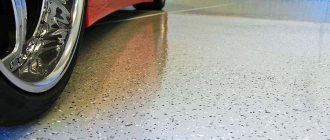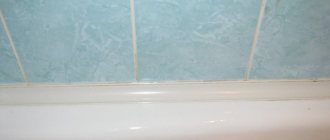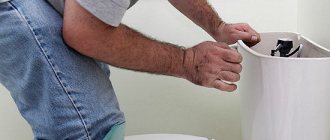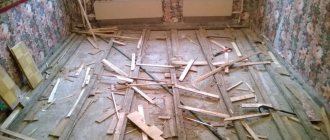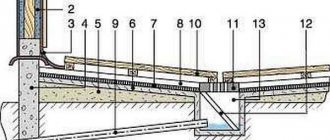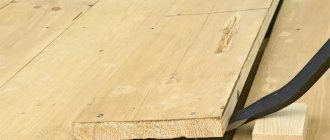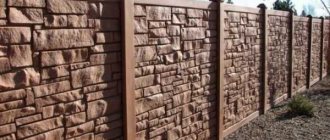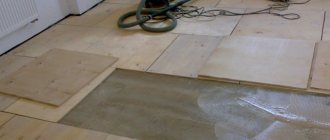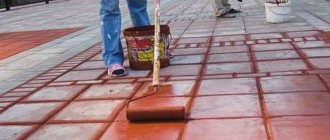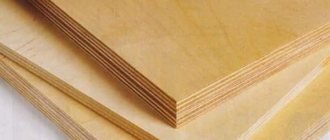Method 1 – impregnation treatment
This is the simplest and most affordable universal way to strengthen a concrete floor. It is used both on a fresh two-week-old screed and on an old dusty base. And also to prepare the surface for subsequent finishing - painting, tiling, etc.
Impregnations (primers, modifiers, primers) for concrete are divided into 2 groups: organic and inorganic based. These are liquid compositions that are applied to the surface with a brush or roller.
Treatment of garage floors with impregnation Source bg.aviarydecor.com
- Organic impregnations are made on an acrylic, polyurethane or epoxy base. Their molecules penetrate the pores of concrete, where they polymerize, making its surface hard, durable and waterproof. Depending on the characteristics of the composition, the strength of concrete increases by 2-10 times, and the result lasts for several years. If you are choosing floors in a garage - which are better and cheaper on a limited budget, then a concrete screed treated with a special organic-based impregnation will be the best option.
Epoxy primer Source beton-house.com
- Inorganic-based compositions affect the surface differently: penetrating into the thickness of concrete, they interact with it, creating additional crystalline bonds. Strength can increase by 50-60 times. One such treatment is enough to forget about dust on the concrete floor forever.
Advice . Pay attention to the instructions on the packaging. Not all compositions are suitable for strengthening low-quality or severely damaged concrete.
Review of impregnations from different manufacturers
To prevent your eyes from running wild in the store, we offer you, as an example, a selection of impregnations from well-known brands - with prices and the most important characteristics.
Notes: *Prices shown are current as of September 2021. ** Consumption depends on the porosity of the concrete. ***Drying time is taken at 20℃.
Strengthening primer for concrete floors Protector
Concrete floors and blocks, cement screed or plastered walls are impregnated with this product so that they do not wear out, do not generate dust, and are not destroyed by aggressive chemicals. The latter will make the Protector primer an excellent base for enamel, epoxy, polyurethane or other coating.
It is better that the primer and paint are from the same manufacturer (whichever one you choose).
- Type of impregnation: organic (acrylic)
- Composition: solution of perchlorovinyl copolymer and acrylic resin in organic solvents with the addition of target components.
- Packaging volume: 20 l
- Price for 1 l*: 189 rub./l
- Consumption**: 0.15-0.3 l per sq.m.
- Use temperature: not lower than -20℃
- Drying time***: 5-6 hours
Concrete m200 (b15): composition, proportions and characteristics
Strengthening composition for concrete "Protector" can be used on coatings in residential and industrial buildings, parking lots, roads, sidewalks, runways, tunnels and swimming pools.
Advantages:
- Easy to apply.
- Protects concrete from dirt and moisture.
- Reduces dust.
Strengthening impregnation Retroplate
With the help of this strengthening impregnation for concrete, dry concrete of low grades (below 300) is strengthened and dust-free, and old concrete, including mosaic, is strengthened. This product does not form a film on it, so after processing it can be coated with any composition.
- Type of impregnation: inorganic (sodium)
- Composition: chemically active water-based silicate polymer
- Packaging volume: 208 l (plastic barrel), 20 l (canister).
- Price for 1 l: 1000
- Consumption: 0.2-0.5 l per sq. m
- Temperature: +5℃ to +50℃
- Drying time: 3 days (but wet cleaning after 2 weeks, second coat after 24 hours!)
Advantages:
- Can be used if the concrete is severely damaged.
- Contains many active components (45%).
- Non-toxic, odorless.
- Not fire hazardous.
Organic impregnation Protexil
Another impregnation that increases the strength of concrete and removes dust from the surface. It is recommended to use it before further finishing work - on the old or new base.
- Type of impregnation: organic
- Composition: PVC resin
- Packaging volume: 20 l.
- Price for 1 liter: 283 rub.
- Consumption: 0.2-0.35 l per 1 sq.m
- Temperature: -40˚С to +80˚С.
- Drying time: up to 6 hours
The composition is designed specifically for high loads and aggressive chemicals, so it can be used in warehouses, parking lots, chemical plants and shopping malls, both for interior and exterior work.
Advantages:
- Penetrates deep into concrete by 5-10 mm.
- Other coatings fit well on it.
- Protects the surface not only from wear, but also from impacts.
Universal impregnation Monolit 20-M
What protects concrete not only from transport loads, but also from organic oils and moisture is the strengthening impregnation for deep penetration concrete Monolith 20-M.
- Type of impregnation: inorganic (lithium)
- Composition: lithium silicate
- Packaging volume: 20 l, 10 l, 1 l (200 l – upon request)
- Price for 1 liter: 140 rub.
- Consumption: 0.2-0.35 l per 1 sq. m
- Temperature: +4℃ to +35℃.
- Drying time: 3 days
Impregnation can be used in the construction of concrete bridges, parking lots, pouring new or strengthening old floors in workshops and warehouses.
Advantages:
- Frost resistance
- Low alkali content
- Breathable material
- Protects fittings from corrosion
- Penetrates 20-50 mm into the material
Impregnation Aquastone
Not only reduces dust formation, but also creates a water-repellent layer. It is applied as a base for a polymer coating to increase the strength of concrete and create good adhesion. Suitable for low grade concrete.
- Type of impregnation: inorganic
- Composition: aqueous solution of inorganic compounds and targeted additives.
- Packaging volume: 24 kg, 12 kg
- Price for 1 kg: 247 rub.
- Consumption: 0.2–0.35 kg per 1 sq.m.
- Temperature: not less than +8°C.
- Drying time: 3-6 hours
Scope of application: car services, parking lots, pharmaceutical and food industry workshops, warehouses, department stores.
Advantages:
- Can be applied to damp substrates
- You can generally replace part of the water in the solution (up to 50%) with this impregnation. Then there is no need to treat the floor surface with it after drying.
- Environmental friendliness
Impregnation Aquasol
Provides moisture protection to various mineral surfaces: concrete, brick, artificial and natural stone.
- Type of impregnation: organic
- Composition: aqueous solution of silicone water repellent with functional additives
- Packaging volume: 1 l, 3 l, 5 l, 10 l
- Price for 1 kg: 239 rub.
- Consumption: 0.1–0.3 l per 1 sq.m.
- Temperature: from +5 to +30°C.
- Drying time: 8-12 hours
Where it can be used: in rooms with high humidity (kitchen, bathroom, boiler room), in country houses, country buildings, on basement floors, for concrete fences and pillars, etc.
DIY concrete countertop
Advantages:
- It is odorless and environmentally friendly, making it suitable for indoor use.
- Protects fittings from corrosion.
- The material is fire and explosion proof.
- The surface after treatment looks the same.
- Does not wash out from vertical surfaces
Impregnation Epoxol
Reduces the absorbent properties of concrete, making it stronger. Creates a breathable and at the same time waterproof base for the final coat. Penetrates deeply (5 mm), making it well suited for walls. Protects them from mold in humid conditions.
- Type of impregnation: organic (epoxy)
- Composition: epoxy resin with the addition of antiseptic active ingredients, functional additives, water
- Packaging volume: 20 kg
- Price for 1 kg: 339 rub.
- Consumption: 0.3–0.4 kg per 1 sq.m.
- Temperature: -40˚С to +80˚С.
- Drying time: 1 day
This impregnation can even be used in children's and preschool institutions, as well as in food, pharmaceutical and chemical industries, car washes and warehouses.
Advantages:
- Environmental friendliness
- Fire safety
- No smell
Impregnation Ashford Formula
This deep penetration water-repellent impregnation for concrete has been on the market for over 65 years. This is no coincidence, because it increases the strength of concrete by 40%, and also makes it waterproof and frost-resistant. Can be applied to fresh concrete (from 24 hours). It does not form a film on top, does not wear out, and does not generate dust.
- Type of impregnation: inorganic
- Composition: water-based silicate polymer
- Packaging volume: 208 l, 20 l, 10 l
- Price for 1 kg: 938 rub./l
- Consumption: 0.14–0.35 l per 1 sq.m.
- Temperature: not lower than +5˚C
- Drying time: 3 days
It can be used anywhere: interior spaces (residential and industrial), areas with pedestrian and traffic load.
Advantages:
- Chemical hardening, changing the structure of concrete.
- Gives concrete a glossy surface, which can be made even more shiny by polishing it. Durable.
- Minimal shrinkage of concrete.
Method 2 – painting
If you need to decide what to cover the concrete floor in the garage to not only remove dust, but also add color, the easiest way is to paint it. But this requires that certain conditions be met:
- The paint must be intended for use on concrete surfaces. It is best if o or similar is present on the packaging. Such coatings are adapted to operating conditions; they have anti-slip and antistatic properties.
Wear-resistant paint for garage Source strmnt.com
- Before painting, the surface must be treated with a primer.
- The primer and paint must have the same base. That is, if a polyurethane decorative coating is chosen, then the concrete should be primed with a similar composition. The same goes for acrylic and epoxy paints.
Before covering a concrete floor with paint, it must be sanded, removing the old decaying layer, as well as complex stains from fuels and lubricants, paints, and grease. The resulting debris and dust are carefully removed using an industrial vacuum cleaner and a damp cloth. Only after this can a primer be applied to the floor.
It is important! No more than 2 hours should pass between cleaning and priming, otherwise dust will settle on the surface again and damage the quality of the impregnation.
The primer is applied in 2 layers with an interval of 10-12 hours between them. After it dries (the time is indicated on the packaging), the floor is also painted in 2 layers with the selected protective and decorative composition.
See also: Catalog of garage projects presented at the Low-Rise Country exhibition.
How to treat concrete floors from dust - simple options
The reliability and durability of a concrete floor depends on compliance with the technology of its pouring.
If everything is done correctly, you will get a smooth base for installing floor coverings. Although the concrete floor itself can become a usable surface, especially in non-residential premises. However, concrete flooring has a big drawback - it generates dust, which results in a serious problem. Therefore, many are interested in the question of how to treat a concrete floor so that it does not generate dust. But before you look into this problem, it’s worth finding out why dust forms on a concrete surface.
The construction market offers a large selection of products that help solve the problem of dust formation in floor coverings. These are toppings and special deep penetration impregnations that protect concrete from the inside. Penetrating into the material, they polymerize, creating crystalline structures in the form of very thin threads, like a cobweb, filling cracks and pores, thereby preventing their expansion.
After such treatment, the top layer of the coating acquires high strength indicators and reliable protection against moisture penetration, and the destructive process stops.
Strengthening impregnations are used in a complex of works if it is necessary to strengthen and remove dust from the coating. Often, after using impregnating compounds, the surface is primed and a polymer coating is applied to it. A good result is ensured by treating the floor covering with Protexil. Its use removes dust from concrete and strengthens it.
Protexil is a liquid composition that penetrates deep into the layers of the screed. It can be used separately or together with other similar products. It penetrates five or more millimeters into the layers, which provides the screed with high strength and long service life.
Protexil will help strengthen the screed and relieve it from dust.
This product is also used when resuscitation of old concrete floors is required. The special composition of Protexil will bring back to life even those coatings that have undergone significant destruction. But before using the product, the surface is prepared. If there are dirt and deposits on it, they are removed.
To get rid of cement dust, the surface is thoroughly cleaned.
Polyurethane mixtures are also considered an effective means of removing dust from screeds. They contain polymers that harden upon contact with moisture. Such impregnating compositions give the best processing results. The main advantage of the mixtures is the ability to penetrate to great depths - 20-40 millimeters.
With such impregnation, a concrete floor will last more than ten years, and this despite the fact that it will constantly be exposed to the environment, temperature changes, high loads, and so on. In addition to the fact that polyurethane mixtures provide good screed strengthening, they are also effective in removing dust.
Polyurethane mixtures eliminate problems with the appearance of dust on concrete surfaces for a long time
But besides the advantages, such mixtures also have disadvantages. They cannot be used if the moisture content of the screed is more than 5%. Therefore, the screed cannot be processed immediately after pouring. You will need to wait some time for excess moisture to come out of the concrete, and only then strengthen and remove dust from the surface.
Considering the characteristics of polyurethane compounds, their cost is somewhat higher than that of other types of mineral impregnations, but they are worth it, because for your money you will get a high-quality result - the floor will not deteriorate and collect dust for many years.
Applying mixtures to concrete surfaces
To get rid of dust on a concrete surface, other means are used - toppings. This processing method provides high results, but working with the mixture takes place in several stages. First you will need to make a concrete screed, then grind it using special equipment.
Dust removal technology is as follows:
- The hardener (topping) is distributed over the surface of the base.
- After the mixture has absorbed moisture, the surface is rubbed, while the mixture penetrates deeper into the base of the concrete.
- After grouting, the hardener is again poured onto the floor and grouted.
- Next, wait two hours and grind. This step gives the surface of the flooring a matte shine.
In facilities where floors are subject to increased loads, a concrete surface is often installed, which is characterized by sufficient strength, durability and affordable cost.
In addition to its advantages, this flooring has a significant drawback - it is very dusty. Is there a way to get rid of this problem?
In preparation:
- First of all, it is necessary to remove all debris from the floor covering, clean it of oily stains and peeling surface layers.
- Cracks and depressions that appear on the surface are sealed and polished in order to level the base and increase the degree of adhesion relative to impregnating compounds and paints (for more details: “How and how to grind a concrete floor - instructions for doing the work yourself”).
- After completing this process, you must remove cement dust using a grinding machine. An industrial vacuum cleaner is used for this. But for a small amount of work, you can use a broom and a damp cloth.
They are primed to enhance adhesion between concrete and paint. Compositions for deep penetration simultaneously perform a number of functions: dust removal, priming, impregnation.
Primers protect concrete floors from:
- fuels and lubricants;
- detergents;
- salt solutions;
- various oils.
The primer is applied 1-2 times with a brush, or with a roller, and for large areas, use a spray gun.
The polyurethane composition can be used as the only surface protection, or applied before the final painting. The best option is to create a topcoat using polyurethane enamel, since both materials consist of identical components. They are applied at 12-hour intervals.
One of the options for solving the problem of whether a concrete floor is dusty or what to do is to paint it. As a result, the treated surface should acquire antistatic and anti-slip qualities. The packaging of paint compositions must contain a mark that they are intended for concrete surfaces (for more details: “Painting a concrete floor - how and how best to do it”).
To create a strong and reliable base for the floor, concrete is often chosen. This is a porous material. The pores are filled with water, air and particles of unbound cement, which did not react to the process of making the mortar. When the top layer begins to break down, the particles turn into dust. In addition to inconvenience, it is harmful to health.
Different technologies and materials can solve the problem. To figure out how to cover a concrete floor so that it does not generate dust, you need to decide when the floor will be treated. Manufacturers offer materials that are used at the time of production of the concrete base or universal for fresh and already used screeds.
In facilities where floors are subject to very high loads, a surface made of concrete is often installed, which has good strength, durability and an attractive price. In addition to its positive qualities, this floor covering has a serious drawback - it generates a lot of dust. Is there a method that makes it possible to get rid of this problem?
- First of all, you should remove all debris from the floor covering, clean it of oily stains and peeling surface layers.
- Cracks and depressions that appear on the surface are sealed and polished in order to level the base and increase the degree of adhesion with respect to impregnating compounds and paints (for more details: “What and how to polish a concrete floor - instructions for doing the work yourself”).
- After this process is completed, the first step is to remove the cement dust using a grinding machine. To do this, use a professional vacuum cleaner. However, if the amount of work is small, you can use a broom and a wet cloth.
READ MORE: Options for laying tiles on the floor
They will be primed to improve adhesion between concrete and paint. Compositions for good penetration simultaneously perform a number of purposes: dust removal, priming, impregnation.
Primers protect the concrete floor from:
- fuels and lubricants;
- detergents;
- salt solutions;
- a variety of oils.
The primer is applied 1-2 times with a brush, or with a roller, and for large areas, use a paint sprayer.
A polyurethane-based composition can be used as the only surface protection, or applied before final painting. An excellent option is to create a final coating using polyurethane enamel, since both materials consist of similar elements. They are applied at 12-hour intervals.
Epoxy primer is used either as a sole coating or simultaneously with paint based on epoxy resins.
One of the options for solving the problem of whether a concrete floor is dusty or what to do is to paint it. Ultimately, the finished surface should acquire antistatic and non-slip qualities. The packaging of the painting compositions should bear a mark that they are intended for concrete surfaces (for more details: “Painting a concrete floor - how and how best to do it”).
The reliability and durability of a concrete floor depends on compliance with the technology of its pouring. If everything is done correctly, you will get a smooth base for installing floor coverings. Although the concrete floor itself can become a usable surface, especially in non-residential premises.
During the operation of a concrete floor covering, its top layer takes on various loads, chemical and mechanical influences, because of this, the destruction of concrete begins, resulting in the formation of cement dust.
- First of all, it is necessary to remove all debris from the floor covering, clean it of oily stains and peeling surface layers.
- Cracks and depressions that appear on the surface are sealed and grinded in order to level the base and increase the degree of adhesion relative to impregnating compounds and paints (for more details: “How and how to grind a concrete floor - instructions for doing the work yourself”).
- After completing this process, you must remove cement dust using a grinding machine. An industrial vacuum cleaner is used for this. But for a small amount of work, you can use a broom and a damp cloth.
Method 3 – rubber paint
When you need to get rid of dust and waterproof your garage floor, what is the best coating material? A relatively inexpensive material for this is rubber or latex paint.
Rubber paint for concrete floors Source www.stroi-baza.ru
It is resistant not only to moisture, but also to aggressive chemical liquids, tolerates low and high temperatures and temperature changes, and has good covering characteristics.
Before applying rubber paint, the concrete surface does not need to be primed, but it is necessary to remove flaking areas and dirty spots. How to seal large potholes and cracks. After removing the dust, the floors are washed first with a soda solution, then with clean water and dried.
This paint is sold ready for use and does not require dilution with solvents. But exceptions are possible, so reading the instructions is mandatory. Before application and during operation, it is stirred periodically. Apply in 2 or 3 layers with a roller or brush at an ambient temperature of at least +5 degrees.
Rubber paint cannot be applied in one thick layer; it is better to apply 2-3 thin layers. Source tgorlovka.com
Painting concrete surfaces
The compositions are used to bind concrete particles, to enhance the strength of the base, wear resistance, water repellency, and to increase resistance to cracking. They are produced:
- liquid formulations. They are based on acrylic, bitumen, styrene-butadiene, epoxy and other synthetic polymers with high elasticity and viscosity;
- dry mixtures. They are used in industrial warehouses, parking lots, aircraft hangars, supermarkets, museums and other premises. Manufacturers pack the material in paper bags and buckets starting from 10 kg.
Liquid compositions include deep penetration primer, dust impregnation for concrete floors, primers: Protexil hardening impregnation of concrete and concrete floors 20 l, price 195 rub./l; Plitonite Grunt-3 strengthening (concentrate 1:3) 3 l, price 481.0 rubles; Deep penetration primer Uzin PE 425 for floors, combined packaging 3 l plus 3 l, price 10,258 rubles. Treating a concrete floor to remove dust with liquid compounds minimizes the problem, but does not completely eliminate its formation.
Dust-removing impregnation for concrete in a liquid state is the simplest option for treating a concrete surface. Impregnation with mineral or polymer compounds is applied to a clean base. The smallest pores of concrete are closed with mineral impregnations. Organic impregnations based on acrylic, polyurethane, and epoxy are used. The coating is carried out in 2 layers.
Acrylic impregnation for concrete against dust protects the concrete base under intense loads. Polyurethane impregnations give concrete strength and a long service life (more than 10 years). The downside of the material is that it produces an unpleasant odor when applied. Epoxy compounds are also durable. But they have a high price.
After rubbing dry mixtures into the surface with a spatula or other tool, the top layer of the concrete base is compacted, its wear resistance increases, and its strength increases 3 times. Dust removal coating for concrete is formed by the following materials: Floor topping Sikafloor 2 SynTop, 25 kg bag, price 1375 rubles, Russia; Neodur HE2 1 kg for 75 rubles, Germany; Weber.floor HB plus/Cerinol HB Korund Plus (25 kg bag), Germany, average price 10 euros.
The big disadvantage of dry compounds is the high cost of materials.
Toppings are applied to a damp, fresh screed at the time of pouring the coating. Powder is poured onto the base in an even layer. To work, you need special equipment - a trowel, which is known as a “helicopter”. If the composition is manually scattered, the process will be labor-intensive. Material consumption – from 3 kg per 1 m2.
Work begins after the poured screed stops being pressed under the weight of a person when walking. 3-4 hours pass.
- The dry topping powder is poured into the cart to be evenly distributed over the entire floor.
- The powder absorbs moisture from fresh concrete.
- In this state, the topping is rubbed into the base with a trowel without any residue. There is no trace of dry powder left on the concrete.
- The procedure of uniformly applying the topping to the entire area is repeated, soaking it with concrete milk.
- The surface is sanded again.
- When the screed has hardened, finishing grouting is carried out. After this, the surface is treated with impregnation.
Before treating the concrete floor to prevent paint dust, it is treated with 2 layers of primer.
Enamels group
The concrete surface is coated with classic domestically produced colored enamels (PF-266, NTs-132) and modified modern dyes. A brush or roller is prepared for work. A seamless gloss coating appears on the base. It can withstand medium loads (foot traffic), exposure to chemicals, water, alkaline and acidic solutions.
The advantage of enamels is ease of application and low price (from 90 rubles per 1 kg).
Modified dyes for concrete surfaces are used in garages. They are produced on the basis of polymer resins: acrylate, epoxy, polyurethane, urethane-alkyd. For example, VEPOX epoxy paint for concrete floors, price RUB 409.00/kg; Polyflex 1101, price 300.0 rubles per kg; Texipol - wear-resistant protective and decorative enamel for 289.0 rubles per kg.
Acrylic enamels are considered durable and affordable. Manufacturers declare a high level of abrasion of compounds on concrete floors in garages; in reality, the coating lasts a maximum of 3 years. It will be updated in the future. Paint for concrete floors Kompozit AK-11 gray, price RUB 435.0/kg.
The level of wear resistance of polyurethane compounds is higher. But the thickness of the covering layer is small and is renewed after 2-7 years. The service life is affected by the intensity of use. The compositions are expensive materials. Polyurethane paint for concrete floors 2-component Duepol (pearl gray) 4 l up to 28 m2, price 8165.0 rubles.
Polymer compositions
This group includes bulk thin-layer dyes that are used both indoors and outdoors. They combine the positive qualities of varnishes and CM.
Compositions with one and two components are used:
- for household use the following series are known: SdelaiFol – Russia, ESP 1615 – Russia, Teknofloor 2K – Finland;
- professional universal compounds for industrial use: PolymerStone - Russia, PG-100 - Germany, Ucrete DP - Germany.
Polymer compositions
- Dust particles reduce the service life of equipment and machinery. It gets into their parts and components, disabling them.
- Dust generated by concrete can harm human health. It causes allergies, respiratory tract, skin and eye diseases.
- An untreated cement surface is difficult to clean. In addition, she always looks unkempt.
- Even if a floor covering is laid on top of the screed, dust removal will still have to be carried out, otherwise the floor will soon begin to creak and crunch under load.
- increased wear resistance;
- high strength to mechanical loads;
- chemical passivity;
- insulating qualities;
- hygiene.
Polymer compositions
To do this, it is recommended to use an industrial vacuum cleaner, which can be rented from a specialized company, as well as a grinding machine. For a small amount of work, an ordinary broom, a household vacuum cleaner and a mop with a damp cloth will be sufficient.
The first option prevents the appearance of cement dust, rather than getting rid of it. It involves strengthening the top concrete layer using a dry mixture, or topping. It is based on cement, to which quartz, corundum, plasticizers and, under significant operating loads, metal particles are added. Additional impurities provide:
Distribution devices are capable of spreading a uniform layer of the required amount of topping over a concrete surface in one pass, which is very convenient. The dry mixture is sprinkled with water so that it gets a little wet, and smoothed using a special paddle machine. As a result, the pores of the concrete are clogged, and the floor acquires an attractive appearance and strength.
To give the layer decorative properties, dyes are added to the topping, which can provide any necessary shade, ridding the surface of the ordinary and not very pleasant gray color. The consumption of the dry mixture depends on the expected loads on the concrete floor.
READ MORE: How and what is the best way to wash linoleum - a review of means and methods
The second method of dust removal is intended for existing concrete floors. Hardening, in this case, occurs due to surface treatment with liquid impregnations:
- on an organic basis - acrylic, polyurethane, epoxy. The porous structure of concrete is filled with organic molecules, and the base is strengthened, becomes waterproof and resistant to chemical influences;
- on an inorganic basis - fluates. Such compositions penetrate into the thickness of concrete and begin to interact with its soluble components, strengthening the base. Fluate can strengthen porous materials so much that it is even used in the construction of runways.
Any impregnation penetrates deeply into the structure of the concrete floor, blocking pores and closing microcracks with voids. Its surface is effectively removed from dust and becomes resistant to mechanical damage, including the effects of abrasives.
Epoxy paint
The finished coating has a presentable appearance, does not turn yellow and is not susceptible to chemical and aggressive environments. Epoxy paint has excellent adhesion to the concrete surface, and the protective layer is quite durable.
Polymer compositions
Method 4 - installation of rubber coatings
Another option for making a floor in a garage if the concrete has begun to gather dust is to lay a ready-made rubber coating on it. Moreover, you can choose rolled materials, slabs of different shapes and sizes, or so-called rubber asphalt.
- Rubber asphalt is a coating created from crumb rubber mixed with polyurethane glue or other polymer binder. Mixing is carried out immediately before laying, and to give the desired color, dyes are added to the still dry crumbs. The finished mixture is immediately applied to the prepared floor, primed with polyurethane glue, quickly leveled and rolled with a roller.
Video description
In the video about seamless coating made from crumb rubber:
See also: Catalog of companies that specialize in finishing and paintwork materials.
- Roll coverings are laid according to the linoleum principle - they are rolled out on a prepared floor, pre-lubricated with polyurethane glue.
- Rubber plates are manufactured in the form of modules with locking connections around the perimeter. From them you can assemble multi-colored coatings, alternating modules in different sequences. Polyurethane glue is also used for fixation.
Laying modular rubber covering Source sroirk.ru
Note . The main disadvantage of rubber coatings is their high cost. Moreover, it directly depends on the thickness of the rubber, which can reach 5 cm. For a garage this is a lot, a layer of 1-1.5 cm is quite enough.
Method 5 – self-leveling floor installation
If the financial side of the question of how to cover the floor in the garage is not of great importance, we can recommend strong, beautiful, durable and extremely resistant to any external influences self-leveling floors. These are plastic fluid mixtures that can independently spread over a surface and level it in a horizontal plane.
There are several types of self-leveling floors depending on the composition:
- concrete;
- epoxy;
- polymer.
Concrete mixtures, which are most often used for garage flooring, have the most affordable price.
Mixtures for self-leveling floors Source ar.decoratex.biz
Method 6 – topping (ironing)
This method is used only for fresh concrete screed, creating a protective layer almost during the process of pouring the coating. It requires the use of special mechanisms, and since it will not be possible to make a high-quality garage floor without them, it is better to entrust the installation of topping protection to specialists.
Definition! Topping (ironization) – strengthening the top layer of a concrete floor. It is produced at the last stage of production and consists of spraying a hardener onto leveled concrete and rubbing it into the surface.
Topping mixtures contain high-quality Portland cement, dye, plasticizers, various mineral additives - quartz, corundum, basalt, silicon carbide and others. Sometimes metal particles are introduced into it to increase strength.
Scheme of a concrete floor with topping Source styazhka-pola.su
The process of strengthening the floor with topping looks like this:
- 3-4 hours after pouring the screed, when it stops being pressed when walking, the topping in the form of a dry mixture is poured into a distribution cart and distributed evenly over the entire area;
- the powder soaked in moisture from fresh concrete is rubbed into the screed with a trowel until no dry substance remains on the surface;
- the rubbed floor is once again sprinkled with topping, soaked in concrete milk and rubbed into the surface again;
- finishing grouting is carried out after the screed has hardened, and then the floor is treated with impregnation or other water-retaining composition.
Causes of dust
During the operation of a concrete floor covering, its top layer takes on various loads, chemical and mechanical influences, because of this, the destruction of concrete begins, resulting in the formation of cement dust.
- violation of concrete pouring technology.
- improperly prepared mixture.
- adding poor quality components to the solution.
Even if concrete has high strength properties, without proper processing and the use of reinforcing compounds it will be subject to the negative effects of abrasive substances, which will lead to surface abrasion, reduced strength and dust formation. If the concrete is of poor quality, it will be subject to corrosion processes, which also leads to dust formation.
There are other reasons why a concrete floor becomes dusty, but those described above are the most common. However, there is a solution to the problem - treating the surface of concrete floors using special compounds. But why to do this is another question, we will answer it below.
Special compositions for dust removal
- due to non-compliance with installation technology;
- due to incorrect composition of the concrete solution;
- due to poor quality components.
But even the strongest concrete floor, without hardening or treatment, is susceptible to the effects of abrasives that fall on it, as a result of which the surface wears out, loses strength and dust appears.
The solution may contain cement, which did not have time to react with water during the preparation of the concrete mixture. It remains in the porous structure of the material as dust, penetrating from time to time into the surrounding space.
Low quality concrete breaks down on its own. And corrosion processes, which also lead to the formation of dust, can occur for various reasons. For example, carbon dioxide reacts with lime in concrete. As a result, microcalcite appears - the same fine dust.
Under mechanical loads on the surface of the base, the top layer is destroyed, unbound particles of substances and cement turn into dust. The dust concentration is high in the laitance layer, which comes to the surface during the curing period of concrete and is a structurally weakened layer.
READ MORE: At what temperature can a concrete screed be poured?
Treating concrete with strengthening mixtures solves this problem
The resulting dust cannot be gotten rid of by sweeping it off the floor surface, as the destruction of the next layer continues. The problem of dust removal from a concrete floor has been helped by modern technologies, thanks to which the surface of the concrete screed at the concrete curing stage is fixed with reinforcing mixtures that rid the floor of dust for the entire period of operation of the base.
If you look at concrete under a microscope, you can see pores of different sizes. They are filled with air, gel substance and water. They also contain unbound substances. They are considered ballast and cause erosion processes in the upper layers of the floor, which are especially fragile.
At the moment the screed hardens, concrete milk comes to the surface. When it dries, it becomes a fragile layer. When it is damaged, dust is formed, so to avoid its appearance, compaction or removal of the brittle layer is required. It can also be bound in a polymeric or crystalline structure. To solve the problem, three approaches are used:
- Surface treatment with strengthening topping.
- Application of grinding.
- Impregnation with a special solution.
